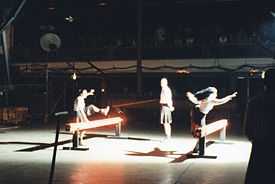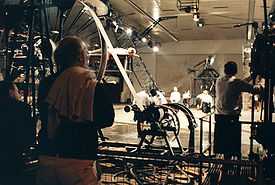Dick Raaymakers
Dick Raaymakers (Raaijmakers) (1 September 1930 - 4 September 2013)[1] was a Dutch composer, theater maker and theorist. He was known as a pioneer in the field of electronic music and tape music. In addition, he realized numerous music theater pieces, art installations, and has published many theoretical essays.
Biography
Raaymakers was born in Maastricht, and studied the piano at the Royal Conservatoire (The Hague). From 1954 to 1960 he worked in the field of electro-acoustic research at Royal Philips Electronics Ltd. in Eindhoven. There, using the alias Kid Baltan, he and Tom Dissevelt, under the name Electrosoniks produced works of popular music by electronic means (which turned out to be the first attempts of their kind in the world).[1] From 1960 to 1962 he then worked at the University of Utrecht as a scientific staff member. From 1963 to 1966, together with Jan Boerman, he worked in his own studio for electronic music in the Hague. Then, from 1966 until his retirement in 1995, he worked as a teacher of Electronic and Contemporary Music at the Royal Conservatoire (The Hague) and since 1991 also as a teacher of Music Theatre at the Image and Sound Interfaculty, at the same conservatory. He died on the third of September, 2013.
Works


Raaymakers’ oeuvre covers a wide variety of genres and styles, varying from sound animations for films to extremely abstract pulse structures, from "action music" to infinite voice patterns, from electro-acoustic tableaux vivants to extracts of music theatre. He is considered as someone who combines disciplines such as visual art, film, literature and theatre with the world of music. Raaymakers has created numerous electronic compositions, "instructional pieces" for string ensembles, phono-kinetic objects, "graphic methods" for tractor and bicycle, "operations" for tape, film, theatre, percussion ensemble, museum and performance, artworks for offices and conservatory, and many soundscape compositions and music theatre productions, including some for the Holland Festival and for theatre company Hollandia. His theoretical essays are evidence of his profound interest in special inter-media connections. For instance, in his latest publication Cahier M (2000) Raaymakers elaborated upon the connections he saw between the 19th-century French physiologist Étienne-Jules Marey, composer Pierre Boulez, architect Iannis Xenakis and the musical views of Piet Mondrian.
One of his most important books is The Method (1985), in which he describes, in an exact but also poetic way, how motion, cause and effect, and their perception are interrelated.
Awards
In the 1990s Raaymakers received several awards for his contribution to the development of visual arts and music in the Netherlands: in 1992 the lifetime's achievement award from the Foundation for Visual Arts, Design and Architecture (BKVB) in Amsterdam, in 1994 the Matthijs Vermeulen Award from the Amsterdam Art Foundation and in 1995 the Ouborg Award for his lifetime's achievement from the City of The Hague. In late 1995 the biennial "Festival in de Branding", organized by the Wagenaar Foundation in The Hague, was dedicated exclusively to Raaymakers’ musical and visual work. In 2005 he received a lifetime's achievement award from the Johan Wagenaar Foundation and an honorary doctorate from the University of Leiden. In November 2011 Raaymakers received the Witteveen+Bos Award for Art+Technology for his entire oeuvre.
Oeuvre
Music theatre productions and art works:
- The Art of Opening an Exhibition (1966)
- Radioproject (1966–1967) Radio Project
- Balade Erlkönig (1967) Erlkönig Ballad
- Grafisch kwartet (1968) Graphic Quartet
- Kwartet (1971) Quartet
- Kwartet heiliger Dankgesang (2000) Quartett heiliger Dankgesang
- Nachtmuziek (1969) Night Music
- Schaakmuziek (1969) Chess Music
- Ideofoon 1 (1970–1973) Ideophone 1
- Ideofoon 2 (1970–1973) Ideophone 2
- Ideofoon 3 (1970–1973) Ideophone 3
- Chairman Mao Is Our Guide (1970)
- De lange mars (1971) The Long March
- Mao leve! (1977) May Mao Live!
- Kwintet (1972–1976) Quintet
- Actio in distans (1977)
- De grafische methode tractor (1976) The Graphic Method Tractor
- De grafische methode fiets (1979) The Graphic Method Bicycle
- De kunst van het machinelezen (1978) The Art of Reading Machines
- Shhh! (1981)
- The Microman (1982)
- Ow! (1983–1984)
- Soundmen (1984)
- Come On! (1984)
- The Soundwall (1982–1984)
- Hey-hey! (1990) Hey-Hey!
- Ping-pong (1983–1996) Ping Pong
- Extase (1984) Extacy
- Acht labielen (1984–1985) Eight Labiles
- Scheuermachine (1985) Scheuer Machine
- Der Stein (1995)
- Scheuer im Haag (1995)
- Tombeau de Glenn Gould (1989)
- Der Fall Leiermann (1991)
- Dépons/Der Fall (1992)
- Der Fall/Dépons (1993)
- Intona (1991)
- Fort-klank (1993) Fort Sound
- Probe (1993)
- De val van Mussolini (1995) The Fall of Mussolini
- Hermans hand (1995) Hermans Hand
- Volta (1995)
- Konzert für ... (1997–2000) Concert for ...
- Proefneming met een tabakspijp (1998–1999) Experiment with a Tobacco Pipe
- De weergave (2000) The Rendition
- Ritueel moment (2005) Ritual Moment
Compositions:
- Song of the 2nd Moon (1957)
- Tweeklank (1959) Contrast
- Pianoforte (1960)
- Vijf Plastieken (1961) Five Sculptures
- Canon-1, super augere (1964)
- Canon-2, super imprimere (1964)
- Canon-3, super addere (1965)
- Canon-4, super sub-trahere (1965/66)
- Canon-5, super ‘dis-moi …’ (1967)
- Ballade Erlkönig voor Luidsprekers (1967) Erlkönig Ballad for Loudspeakers
- Filmmuziek-1: Mechanical Motions (1960)
- Filmmuziek-2: Bekaert (1966)
- Filmmuziek-3: Sidmar (1969)
- Chairman Mao Is Our Guide (1970)
- De lange mars (1971) The Long March
- Mao Leve! (1977) May Mao Live!
- Ach! Ach! (1987) My! My!
- Plumes (1967)
- Flux (1967)
- Lied van de Arbeid (1976) Ode to Labor
- Kwartet (1971) Quartet
- Ping-pong (1983) Ping Pong
- Der Fall Leiermann (1991)
- Du Armer! (1993)
- Vier Fanfares (1995) Four Fanfares
Publications
- Raaijmakers, D. Cahier ‘M’: a Brief Morphology of Electric Sound. Revised Edition. Series: Collected Writings of the Orpheus Institute. Translated by Richard Barrett. Leuven: Leuven University Press (2005)
- Mulder, Arjen & Joke Brouwer (eds.) Dick Raaymakers - A Monograph. Rotterdam: V2_ Publishing (2008) http://www.dickraaijmakers.nl
- Raaijmakers, D. Method. Edited and translated by Vincent W.J. van Gerven Oei. Eindhoven: Onomatopee (2009) http://www.onomatopee.net
- Raaijmakers, D. The Destructive Character. Edited and translated by Vincent W.J. van Gerven Oei. Eindhoven: Onomatopee (2010) http://www.onomatopee.net
References
External links
- Video on YouTube Sonik Re-Entry 1957
- Video on YouTube Intona (1992)
- Video on YouTube Intona (Full Version) (1992)
- Dick Raaymakers at v2.nl
|